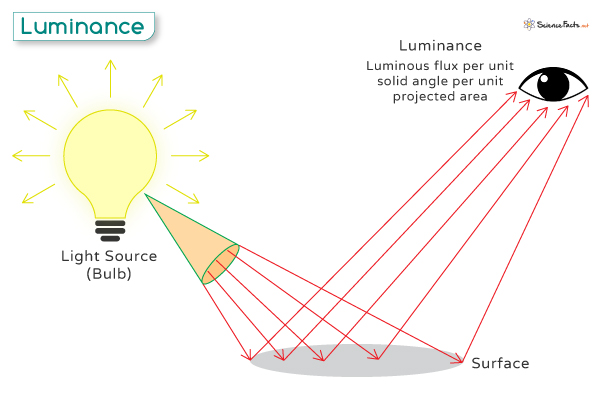Luminance
Luminance measures the amount of light emitted, passed through, or reflected from a particular area. It indicates how bright a surface will appear to the human eye. It is closely tied to a surface’s physical characteristics and is essential because it affects how we see and understand the world.
Luminance is crucial in designing cellphone screens, making them easy to see and use. Because their luminance differs, some screens look sharper and more vivid than others.
Formula
Mathematically, luminance is defined as the amount of luminous flux per unit projected area per unit solid angle. It is denoted by the symbol “L”. The formula for luminance is derived from the ratio of luminous flux to the product of projected area and solid angle. This core formula is expressed as follows:
Where:
-dφ represents the luminous flux in lumens (lm)
-dA is the differential area in square meters (m²)
-dω is the differential solid angle in steradians (sr)
-θ stands for the angle between the normal to the surface and the line of sight
Unit
SI System: A widely used unit is candela per square meter (cd/m²). This unit is fundamental in expressing luminance as the amount of light emitted or reflected from each square meter of the surface. The nit (nt) is a non-SI name also used for this unit (1 nt = 1 cd/m2).
CGS System: A lesser-known unit is stilb. 1 stilb = 1 candela per square centimeter or 1 sb = 1 cd/cm2.
Examples
Here are some real-world examples showcasing luminance values. A light meter is a device used to measure luminance.
| Object | Luminance (cd/m2) |
|---|---|
| Computer monitor | 250 to 350 cd/m2 |
| Moon, when observed through a clear atmosphere | 2.5 x 103 cd/m² |
| Filament of a tungsten incandescent lamp | 107 cd/m2 |
| Sun | 1.6 x 109 cd/m² |
Applications
Luminance is essential in daily life because it affects how we see light.
- TVs and digital screens (computers and cellphones): They must have the right amount of luminance so that what we see is bright, clear, and easy on our eyes.
- Photography and Movies: Luminance helps creators make stunning visuals by controlling how light and darkness look. It lets them create different feelings or make certain things stand out in a picture or scene.
Is Luminance the Same as Brightness
Luminance and brightness are related concepts in photometry and visual perception. They are often used interchangeably to distinguish how we perceive light.
Luminance quantifies the amount of light passing through or emitted from a particular area and falling within a given solid angle. On the other hand, brightness encompasses a broader, subjective aspect, allowing an observer to identify a light source as emitting more or less light. It refers to how bright or dark an object appears to a viewer.
-
References
Article was last reviewed on Saturday, May 25, 2024








